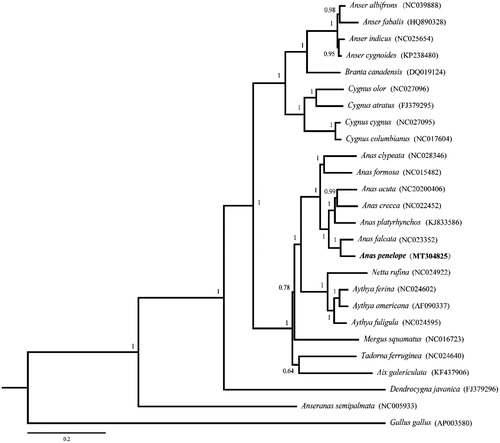Abstract
The complete mitochondrial DNA genome of the Eurasian Wigeon, Anas penelope, was mapped by the next-generation sequencing and Mega 7.0. The circular mitogenome (16,596 bp in length) contains 13 protein-coding genes, 2 rRNA genes (12S ribosomal RNA and 16S ribosomal RNA), 22 tRNA genes and a control region. The content of four base pairs of the complete mitochondrial DNA is 28.9% of A, 22.3%of T, 32.7%of C and 16.1% of G. To validate the phylogenetic relationship, 25 published complete mitochondrial genomes of Anseriformesalong with the genome of Terek sandpiper were used to construct the phylogenetic tree.
Keywords:
The Eurasian Wigeon (Anas penelope) is a widespread duckspecies estimated to number 2,800,000–3,300,000 individuals (IUCN Citation2016). The overall population trend of A. penelope is decreasing due to recreational impacts, dams, water management, and prion-induced diseases (Lei et al. Citation2008). Except for some behavioral and habitat research, A. penelope is less well studied in literature (Guillemain et al. Citation2002; Mayhew and Houston Citation2008). Mitochondrial DNA (mtDNA) is regarded as a useful tool in population conservation, phylogeographic, and phylogenetic studies. The mitochondrial DNA control region of A. penelope was examined to assess the genetic differentiation (Kulikova & Zhuravlev Citation2010). Hence, it is necessary to obtain the complete mitochondrial DNA by the next-generation sequencing. The muscle specimen of A. penelope was collected from the coast of Rudong Country, Jiangsu Province, China (32°32′43.42ʺ N, 121°06′09.02ʺ E). A voucher specimen was stored in Nanjing Normal University (NJNU: ANPE20191005), Nanjing, China. The complete genome sequence was aligned by Mega 7.0 and deposited in GenBank (Accession Number: MT304825).
The complete mitochondrial genome of A. penelope is circular molecular and 16,596 bp in length. The genome contains 37 genes, including 13 protein-coding genes, 2 ribosomal RNAs, 22 tRNA genes, and a control region (D-loop). Most of the genes were encoded on the H-strand, while ND6 and 8tRNA were encoded on the L-strand. For the 13 PCGs, the most common start codon is ATG, followed byGTG. The termination codon (TAA) is most common and two protein-coding genes (COIII and ND4) use single T as their stop codons, which were presumably completed as TAA by post transcriptional polyadenylation . The base composition of mtDNA is A(28.9%), G(16.1%), C(32.7%) and T(22.3%), and thus the percentage of G and C (48.8%) was slightly lower than A and T (51.2%).
To confirm the phylogenetic position of A. penelope among Anseriformes species, a Bayesian analysis was conducted on the complete mitogenome. It is shown that the phylogenetic relationship of A. penelope is very close to the A. falcatein the family Anatidae (). We hope this study will provide more information for the phylogenetic analyses of Anseriformes in future research.
Disclosure statement
No potential conflict of interest was reported by the author(s).
Data availability statement
The data that support the findings of this study are openly availablein NCBI at www.ncbi.nlm.nih.gov, reference number (MT304825).
Additional information
Funding
References
- Guillemain M, Martin GR, Fritz H. 2002. Feeding methods, visual fields and vigilance in dabbling ducks (Anatidae). Funct Ecol. 16(4):522–529.
- IUCN 2016. IUCN Red List of Threatened Species (ver. 2016.1); [Accessed 2016 July 31]. http://www.iucnredlist.org.
- Kulikova IV, Zhuravlev YN. 2010. Genetic structure of the Far Eastern population of Eurasian wigeon Anas penelope inferred from sequencing of the mitochondrial DNA control region. Russ J Genet. 46(8):976–981.
- Lei C, Mark B, Gang L. 2008. New Anatidae population estimates for eastern China: implications for current flyway estimates. Biol Conserv. 141(9):2301–2309.
- Mayhew P, Houston D. 2008. Feeding site selection by Wigeon Anas penelope in relation to water. IBIS. 131(1):1–8.

